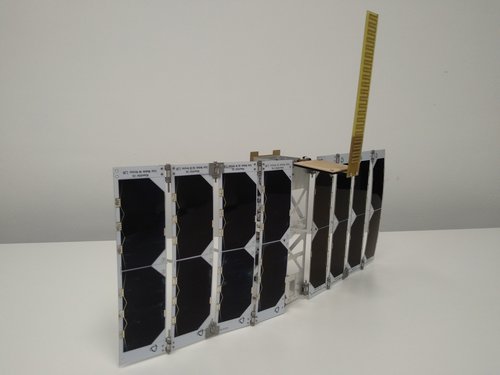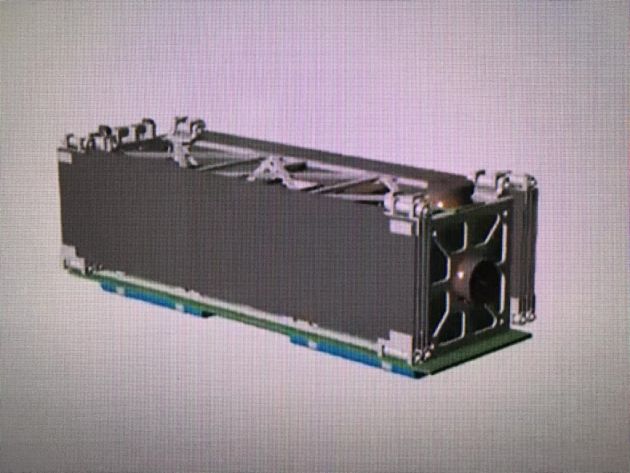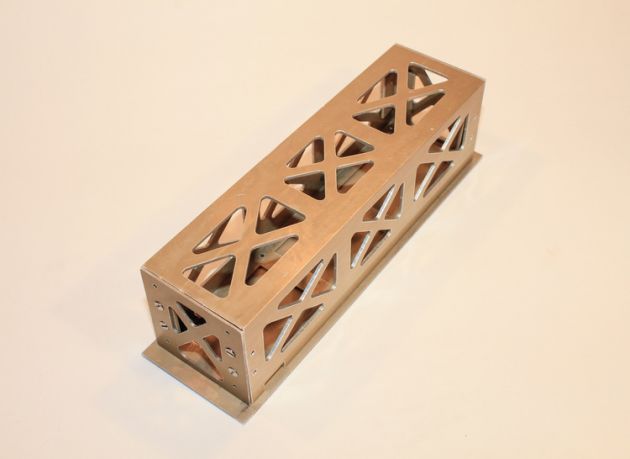SaaS as a business opportunity
Fundraising campaign by
Eugenio Chiappa
-
€3.00raised of €300,000.00 goal goal
Campaign Story
INTRODUCTION
The democratization of space is a growing phenomenon, involving the introduction of new actors and business opportunities. Just as the Internet was once the breeding ground for hundreds of startups, today space is the ecosystem providing a background for countless enterprising ideas.
Large companies and startups are using space in order to do business on Earth as it enables them to offer new services or generate key data for processing and commercialization purposes.
A new wave of colonization is being carried out by small, fast and inexpensive systems that is enabling companies that need space in order to reach their objectives and expand their services to gain a foothold in this area. Hundreds of startups are benefiting from the savings involved in the new nanosatellite constellations.
This nanosatellite revolution requires a new spatial ecosystem suitable for its constellations: a brand new productive environment that includes stations, satellite control and monitoring software, specialized subsystems, solar panels, batteries and rockets, etc.
Now more than ever, space is seen as a commercial enterprise. Large, medium-sized and startup businesses are all heading towards the final business frontier.
A PocketQube is a type of miniaturized satellite used for space research; it occupies a volume of about 5 cm³ (one eighth of the volume of a CubeSat), weighs no more than 250 grams and generally uses ready-to-use commercial electronic components for its electronics.
Since 2009, Morehead State University (MSU) and Kentucky Space have developed PocketQube specifications to help universities around the world carry out space exploration activities. While most of the development comes from academia, several companies build PocketQube, such as GAUSS Srl, Fossa Systems, and Alba Orbital.
EXECUTIVE SUMMARY
Our first objective is to launch a prototype vehicle into space to prove that the technology works. We will do this by raising the capital for a proof of concept prototype through fundraising, investment and/or crowd funding.
The aim is to raise €300000, this money would be used with the intention of building a working prototype to prove our concept is feasible in the real world as well as it is theoretically.
The purpose of this investment business plan is to help formalize the business strategy, as well as to provide evidence that is a worthy investment for a line of credit.
1.1 Objectives
With the minimum amount of money we have stated we need, we will have a chance to prove our concept. The breakdown of how the money will be spent is below:
- Platform Only
- Launch
- Ground Station
- Payload
We will want to be a new space technology company start up looking to raise funds to build proof of concept vehicles, based on our Intellectual Property assets. Currently we have not started generating revenue.
The ultimate objective for us is to build a constellation of Earth monitoring satellites. Instead of large and expensive satellites, we want to create a new system using very tiny satellites that talk to each other and relay data to Earth as a group. This will allow for a near constant monitoring of resources, nearly in real time. Because they are small, easily built, and inexpensive, we can launch a large number of them and if one fails, the rest can continue to function. With a 5-year lifespan, inexpensive cost, and low, sun-synchronous orbit.
To cover the Earth for a global service, the satellites must be launched into a minimum of 5 orbits, each requiring a dedicated launch vehicle. For simple applications, 80 satellites can provide global coverage. For demanding applications, such as providing high bandwidth communication, up to 3,000 satellites may be required for global coverage. The equatorial region and the polar areas are special cases where coverage can be provided with a few satellites. Satellite constellations must be replaced every 5 years in orbit – I.e. 20% of all launched satellites must be renewed every year.
1.2 Mission
Make a prototype and test it in space, to make nanosatellites the preferred choice for customers who have demands for professional mission critical radio based surveillance and communications solutions.
1.3 Keys to Success
- Application development requires knowledge of deep space.
- Develop and offer payload products.
- Convince organizations that are not space savvy that they can benefit from this.
- Conventional multi-million satellites market can be disrupted with with low cost, highly flexible nano-satellites.
ORGANIZATION SUMMARY
A start-up is formed as a non-profit corporation, and the majority of revenue is raised through grants and other fundraising efforts.
2.1 Legal Entity
The start-up is a non-profit company incorporated in Switzerland.
The board of directors will be made up of several high-profile professors and business professionals living in Switzerland and Italy.
2.2 Startup Summary
The company starts out as a running business with very little debt and a lot of working capital - cash. The idea behind this type of startup plan is to keep overheads to a minimum. The second largest startup expense that affects free cash flow is the contract payment with the designated provider (Alba Orbital).
Start-up Funding
| Start-up Expenses to Fund | €275.000 |
| Start-up Assets to Fund | €25.000 |
| Total Funding Required | €300.000 |
Assets
| Non-cash Assets from Start-up | €10.000 |
| Cash Requirements from Start-up | €15.000 |
| Additional Cash Raised | €0 |
| Cash Balance on Starting Date | €0 |
| Total Assets | €25.000 |
Liabilities and Capital
| Liabilities | - |
| Current Borrowing | €0 |
| Long-term Liabilities | €0 |
| Accounts Payable (Outstanding Bills) | €0 |
| Other Current Liabilities (interest-free) | €0 |
| Total Liabilities | €0 |
| Capital | - |
| Planned Investment | - |
| Bill Alba Orbital | €249.000 |
| Other | €0 |
| Additional Investment Requirement | €0 |
| Total Planned Investment | €275.000 |
| Loss at Start-up (Start-up Expenses) | (€26.000) |
| Total Capital | €249.000 |
| Total Capital and Liabilities | €25.000 |
| Total Funding | €300.000 |
Start-up
Requirements
Start-up Expenses
| Legal | €7.000 |
| Stationery etc. | €1.100 |
| Brochures | €500 |
| Insurance | €400 |
| Rent | €2.000 |
| Expensed Equipment | €15.000 |
| Total Start-up Expenses | €26.000 |
Start-up Assets
| Cash Required | €10.000 |
| Start-up Inventory | €0 |
| Other Current Assets | €0 |
| Long-term Assets | €15.000 |
| Total Assets | €25.000 |
| Total Requirements | €300.000 |
PRODUCTS AND SERVICES
Needs Analysis: Determine what technology gaps exist in decision making process, recommend changes.
Coaching: Guide the owner through various scenarios, help them purchase tools and technology, build on technological synergies with client’s customers, push owner to test the limits of their technological capabilities and potential.
Procurement Sourcing: Establish long-term channels and determine technology suppliers. Manage sourcing and recommend upgrades on a quarterly basis.
MARKET ANALYSIS SUMMARY
Satellites are no longer the exclusive domain of rival superpowers, but instead a business opportunity based on the falling technology costs.
In 2017, more than 300 nanosatellites were launched into space, a year-on-year increase of 205%. Emerging operators, new sources of funding and the new applications open to businesses and users are the reasons behind a trend that looks set to continue over the coming years.
Whilst between 2013 and 2017 almost half the nanosatellites were launched on military or civil missions, and the remaining half for business purposes, the outlook for the next few years is radically different. By 2022 up to 75% of all nanosatellites are forecast to be in orbit for commercial reasons.

4.1 Market Segmentation
Market segments:
- Smart Metering
- Remote Management
- Crop Controls
- Meteorology
- Tracking Economic Activity
- ADS-B System
- Ship Tracking
- Fleet Management
4.2 Target Market Segment Strategy
Target markets are important to our overall strategy because there are two needs:
- Nanosatellites allow for machines and objects to communicate with one another. All that is needed is an identifier allowing for asset data and a connection enabling the nanosatellites to receive all types of information, including speed, temperature and energy consumption gauging, etc. These smart measurements are not only essential in order to foresee future events and adopt the necessary decisions, but also to analyse records in order to detect problems.
- IoT technologies allow for the management and handling of all types of assets wherever they may be, based on the use of specific software. The satellites provide this communication with key assets located in remote areas and deliver the data companies require to carry out their activities and boost their efficiency levels.
STRATEGY AND IMPLEMENTATION SUMMARY
Our plan is to launch a prototype by 2021 in a 500 km (310 miles) synchronous solar orbit. The ultimate objective for us is to build a constellation of Earth monitoring satellites.
5.1 Fundraising Strategy
The largest expected revenue generator is through the GoGetFunding.
5.2 Launch Opportunities from Alba Orbital

Organizer
- Eugenio Chiappa
- Campaign Owner
Donors
- Anonymous
- Donated on Nov 20, 2020
- Anonymous
- Donated on Oct 23, 2020
- Anonymous
- Donated on Oct 13, 2020
No updates for this campaign just yet
Donors & Comments
- Anonymous
- Donated on Nov 20, 2020
- Anonymous
- Donated on Oct 23, 2020
- Anonymous
- Donated on Oct 13, 2020



-630x473.jpg)




